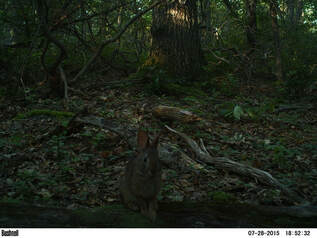 A New England cottontail rests on a log in a Hudson Valley forest.
A New England cottontail rests on a log in a Hudson Valley forest. However, today, the connections between the individual patches making up metapopulations are increasingly fragmented by roads, human development, or otherwise altered habitat. As a result, metapopulations may be fragmented into multiple, smaller parts and their individual patches may more frequently blink out and it may take longer for them to be recolonized-or they may never be recolonized. The end result is population declines as individual patches are lost but never recolonized leading to an increased susceptibility to permanent metapopulation extinction.
Recent research led by Dr. Amanda Cheeseman of SUNY-ESF suggests that this scenario is occurring in even the most secure populations of New England cottontails raising concerns for the status and long term stability of populations in New York and across their range. Her work, recently published in Conservation Genetics builds off of a rich literature suggesting that populations of New England cottontails are highly susceptible to metapopulation breakdown as a result of habitat loss and poor connectivity among remnant populations. Her findings suggest that habitat loss and fragmentation by roads in New York have created a patchwork of unsustainably small populations, each displaying indicators of decreased genetic diversity.
Restoring connectivity among fragmented metapopulations in an effort to increase population size to sustainable levels should be a priority for managers. A combination of habitat creation, a focus on creating wildlife corridors, and translocation and reintroduction efforts may be necessary to achieve these goals.
 RSS Feed
RSS Feed
